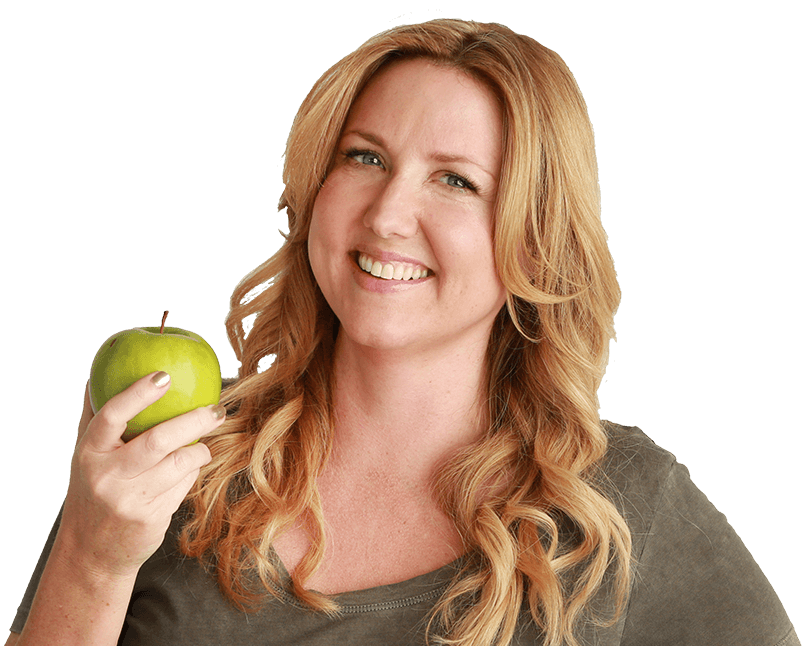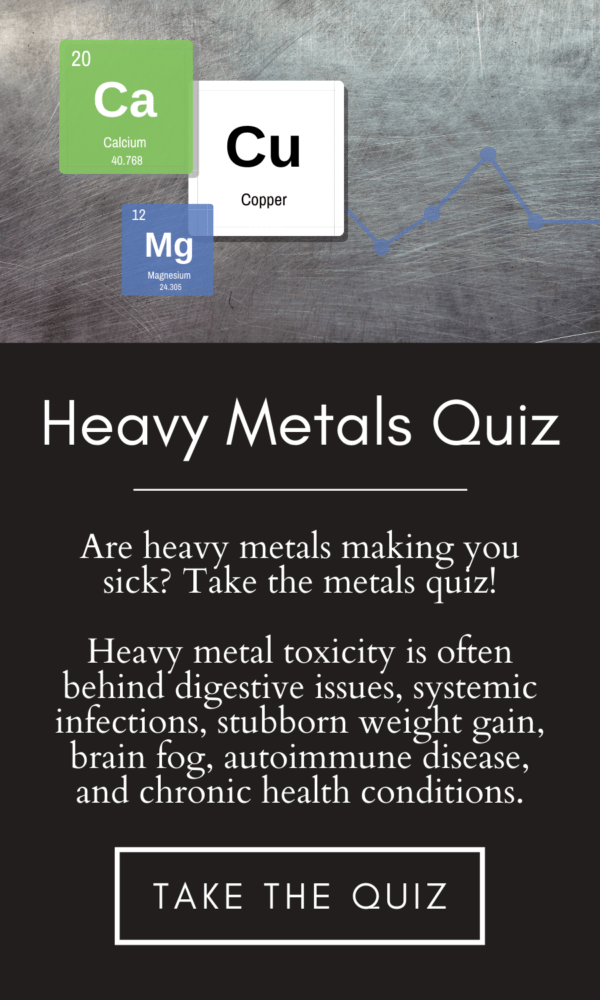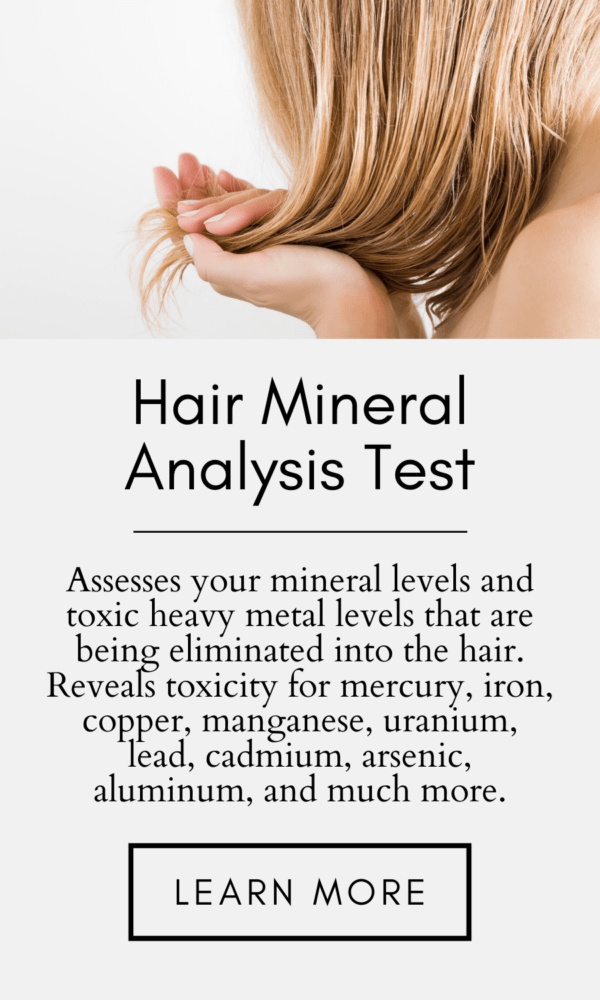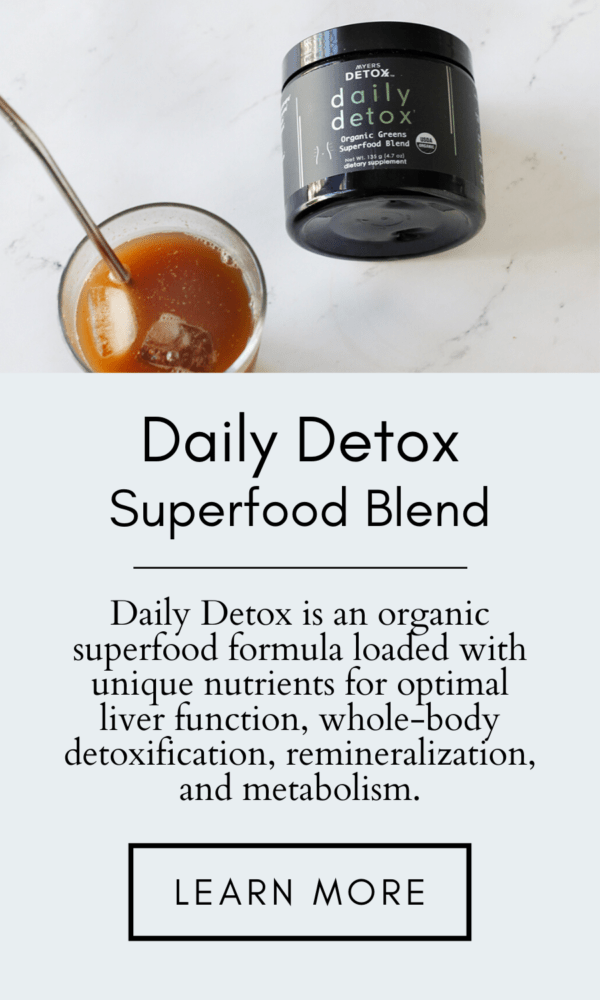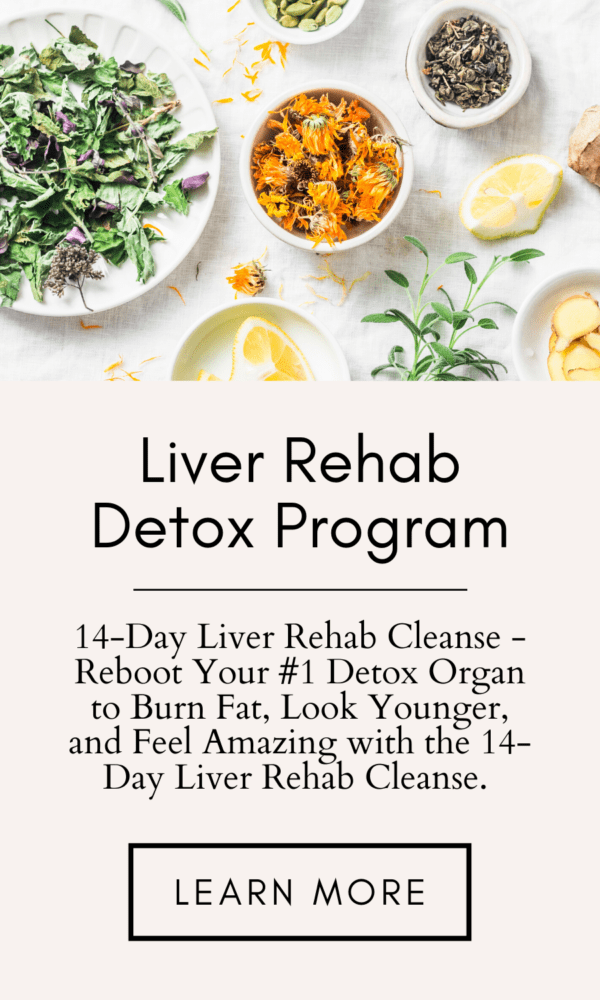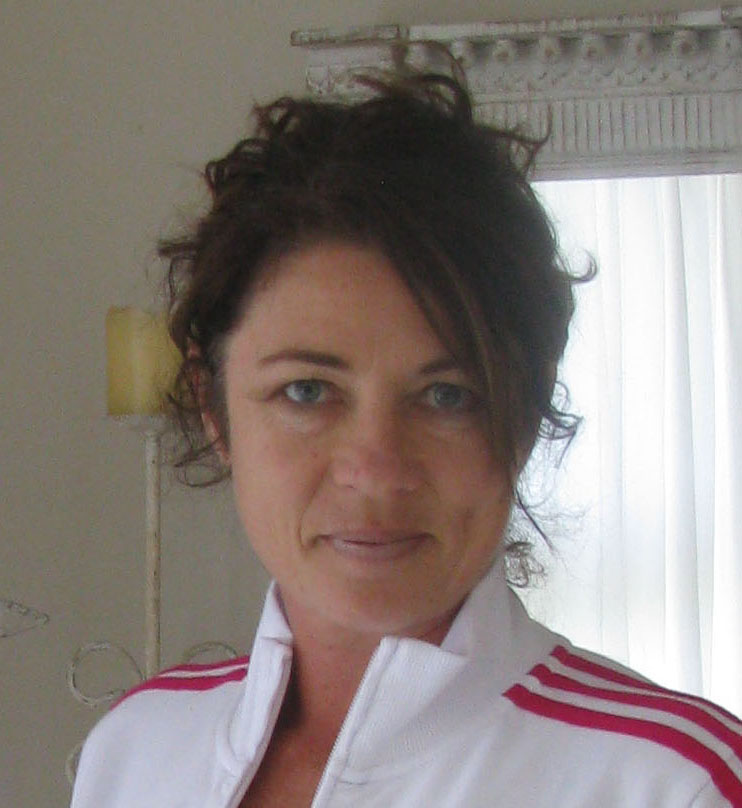Transcript #458 Top Tips to Reduce Stress and Improve HRV with Dr. Jay Wiles
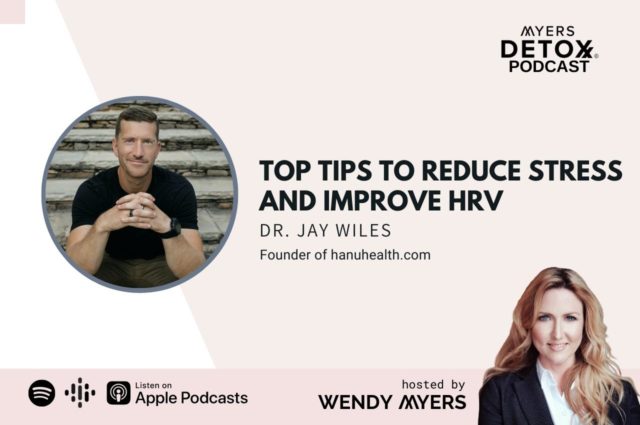
Listen
Listen to this podcast or watch the video. CLICK HERE
Transcript
Download PDF
Click to jump to a section!
- Find out what’s in store on this Myers Detox Podcast with Dr. Jay Wiles, who joins the show to talk about the best ways to improve your stress levels and stress resiliency, and his incredible product he developed called Hanu Health. Dr. Wiles does a deep dive into what HRV or heart rate variability is, why it is so important to our health, and how it is actually measured. So many incredible topics covered in this episode, so make sure to tune in if you’re looking to improve you body’s ability to handle stress!
- Learn more about Dr. Wiles’ story and how he got into the health field.
- Learn more about what HRV is and what exactly it is measuring.
- Find out all of the main factors that affect your HRV.
- Learn more about how HRV is scored, and why it is most important that you are able to modulate your HRV.
- Find out how emotional trauma affects people’s HRV.
- Learn about some of the tops myths regarding HRV.
- Learn more about Dr. Wiles incredible product Hanu Health, and how this product helps you track and improve your HRV.
- Find out some of the tops ways you can improve your stress resiliency and HRV.
- Learn about HRV Biofeedback and what it is effective for.
- Find out some of Dr. Wiles top recommendations for reducing stress.
Dr. Wendy Myers: Hello everyone. Welcome to the Myers Detox Podcast. I’m Dr. Wendy Myers, and on this show, I talk about all the different things related to detoxification, improving your health, biohacking, and emotional detoxification, as well.
And today’s show, we’re going to be talking to Dr. Jay Wiles, and he’s a co-host of the Ben Greenfield Podcast since 2019, and he’s going to be talking to us about HRV, which is your heart rate variability, and stress, how to improve your stress levels and stress resiliency, and his product he developed called Hanu Health, which is an app and biofeedback system to help improve your HRV and track it.
It’s a really good show today, and we also talk about the factors that affect your HRV, health conditions, and lifestyle factors. We talk about the best ways to improve your heart rate variability and the fact that your HRV, a measure of stress, is a greater predictor of mortality than smoking, obesity, heart disease, high cholesterol, and so many other factors, and your socioeconomic level.
You need to be looking at your HRV and tracking it, and finding things that improve it, and we will talk about what your HRV number should be. Should you compare your HRV number to other people’s? Are you comparing apples to oranges there? We talk about all the nuances of HRV and how it can improve stress, performance, and things of that nature, so great show. So tune it.
This podcast is brought to you by Danette May and Mindful Health LLC, featuring Danette May’s top superfood product from our Earth Echo Foods line called Cacao Bliss. I love Cacao Bliss. It’s so delicious, and nothing feels better than enjoying rich, smooth, creamy chocolate and knowing that you’re doing something good for your body.
They start with 100% organic cacao beans. They’re naturally kissed by the sun, maintaining their miraculous health benefits, and then they blend with turmeric, MCT oil, coconut, Himalayan sea salt, cinnamon, and black pepper for the perfect blend to make you feel the best that you ever have.
And the result is that you fall in love with a truly decadent, healthy, guilt-free chocolate, removing your cravings, facilitating weight loss, boosting your energy, and reducing your inflammation with one simple drink. Not only that, but it’s friendly to paleo, it’s gluten-free, it’s keto, and it’s also friendly to vegan and vegetarian diets.
And for the last eight years, they have been a leader in the superfoods market and are proud to serve millions of customers worldwide, so you can try some Cacao Bliss and get 15% off by using the code detox. Go to the link shop.earthechofoods.com/mdetox, and you can learn more at Instagram @TheDanetteMay and @EarthEchoFoods.
Our guest today, Dr. Jay Wiles, is an international speaker, scientist, clinician, influencer, and subject matter expert and authority on the interconnection between human stress response and human performance and optimization. Dr. Wiles is a clinical health and performance psychologist with board certification in heart rate variability, biofeedback, and peripheral biofeedback, and he works as a leading consultant to psychophysiology, health influencers, professional athletes and teams, executives, and high performers.
He is the co-founder and chief scientific officer of Hanu Health, and he has pioneered new and innovative means of using heart rate variability and respiratory training as both diagnostic indicators of the dynamic nature of the human stress response, alongside therapeutic tools for regulating and conditioning this response for peak human performance.
Dr. Wiles has an extensive history of working with top-performing athletes in the PGA, the LPGA, MLS, MLB, ATP, and WTA, and his consulting firm, Thrive Wellness and Performance, has held contracts with leading biotechnology and health technology organizations where he’s engaged in research, development of therapeutics, and development of behavioral retention programs.
Dr. Wiles has been the co-host of the Ben Greenfield podcast since 2019 and also hosts the Hanu Health podcast. You can learn more about Dr. Wiles and his work at HanuHealth.com. Jay, thank you so much for coming to the show.
Dr. Jay Wiles: Yeah, thanks so much for having me on, Wendy.
Dr. Wendy Myers: So tell me a little bit about yourself and how you got into the health field.
Dr. Jay Wiles: Yeah, so I am a clinical health psychologist by trade, so I went to school for clinical psychology, which is really more focused on working with individuals who have mental health-related disorders, typically more significant and persistent types of mental disorders.
However, I specialize in the field of health and performance psychology because I was very interested in studying the intersection between physiological and psychological health and that bidirectional pathway. Throughout school, I became even more interested in the field of integrative health, particularly in looking at the effects of nutrition, what we put into our bodies, our relationship with food, and how these things interact.
But then also, just how can we measure changes in the human stress response through physiology? And I didn’t really come upon this because I necessarily had an innate interest in that. I liked the idea of biometrics, but when I was in school, Fitbit was around, but other types of biometric companies and wearable companies hadn’t started. There was no such thing as the Apple Watch. There was no such thing as, Whoop, Oura or any of these other more notable types of wearable companies.
So when I saw biometrics really at work for the first time, it was on medical grade types of platforms, so utilizing EKGs or EMGs or thermometer testing, all these things were more the standard of what was used, and now we have all this on our finger and on our wrist. It’s pretty incredible how tech is advanced.
But I was working in an integrative pain center. I was working with the Department of Veteran Affairs at the time. I was a resident, and this program was intended to help veterans titrate off opioid-based medications, so they were not prescribing medications. They were really working on getting veterans off of medications, and they used a wide array of integrative platforms and therapeutics, things as acupuncture and nutritional therapies and guided imagery, meditation, mindfulness, Tai Chi, and Qigong.
And then, one they utilized, which I was really fascinated with, was biofeedback. And I had heard of biofeedback probably within graduate school or training, but I’d never actually got to train with it. I wasn’t really exposed to it until this time. And at first, it seemed a bit cheesy, like we’re just hooking people up to monitor their physiology and then have them pace their breathing.
But the thing is, and we ended up publishing these results, is that we started seeing that these veterans were making significant strides in reducing their overall subjective experience of pain. And I said, “Okay, there might be something to this, so what is it?” And that kind of led me down the rabbit trail. That is, I became interested in heart rate variability and peripheral biofeedback. I ended up getting double-board certified in biofeedback, and the rest is history. And now, in the health and wellness field, I’m known as the subject matter expert in heart rate variability and in biofeedback, and now I own a company that actually does all biofeedback and monitors the human stress response at all times, so that was very much a truncated version of what’s happened to me over the previous, let’s say, 10 to 15 years. But it’s been a fun ride. It’s great to see where tech has come to. Yeah, that’s what got me into this.
Dr. Wendy Myers: Yeah. Well, it’s great that you’re focusing on this because so many people are stressed today. It’s the number one killer. Stress kills more. HRV is a measure of mortality. It’s more important than cigarette smoking, high cholesterol, and heart disease. There are amazing studies out there that show how important HRV is and how it’s a measure of stress. And so, can you tell us a little bit more about what HRV is, exactly, and what it’s measuring?
Dr. Jay Wiles: Sure. Yeah. Heart rate variability is something that’s pretty accessible to almost everybody nowadays. If you utilize any type of wearable tech, you will see that heart rate variability is typically a metric that’s provided, especially as people sleep. And there are other modalities of checking HRV. And then with Hanu, my company, not to shamelessly plug us, but we look at it and track it all the time, so whenever you’re wearing the device.
The intention behind heart rate variability is, as you mentioned, it is a great proxy. I would say it is the single greatest, a non-invasive proxy for measuring the dynamic changes or shifts in the human stress response. So what that means is that we can look at this number, and then when we compare it over time, we can actually determine whether or not someone is experiencing physiological and psychological stress and how that is manifesting in their overall physiology?
So heart rate variability, I always like to explain it in terms, kind of like an example that people can relate to. So people can relate typically to what heart rate is, and they understand intuitively what heart rate is, but heart rate variability is a little bit more nuanced and quite complex.
So when we think about heart rate variability, we’re really looking at the time differences or the amounts of variability that occur between adjacent heartbeats. So with heart rate, if someone were to say, “Okay, I’m looking at your wristwatch,” it’s looking at heart rate, and it says, “You have a heart rate right now of 60 beats per minute.” Well, that means that over the course of one minute, your heartbeat was pacing at an average of once every second.
Now, intuitively that sounds like, “Yeah, that makes sense. Okay, so every single second, my heart was beating.” Well, if that was taking place, then we end up having a heart rate variability of zero, and that’s because the heart rate does not operate like a metronome. The cardiovascular system is not established to work like a metronome unless under certain conditions, and we can talk about that.
And so what has to happen is that we know that the heart speeds up and slows down across our respiratory and breathing cycles. It speeds up, and it slows down. There’s a rhythm to it. And then there’s actually an arrhythmia to it, as well. And what we know is that, across the cycle, when there are changes, that variance is really due to the dynamic shifts in the autonomic nervous system.
Now, the autonomic nervous system is responsible for our stress response and our relaxation response, and it’s kind of like these two-headed nervous system branches that we have that really dictate whether or not someone is experiencing more heightened stress or reduction in stress, which we would call relaxation. So the core of heart rate variability is telling us about the dynamic shifts in someone’s stress response.
Dr. Wendy Myers: Okay, great. And so what are some of the key factors or health issues that will negatively affect or even possibly affect the HRV?
Dr. Jay Wiles: Yeah, so the single greatest thing that we know is that stress will be the predominant factor that will affect heart rate variability. Stress could be physiological stress, so you could be doing a lot of physiological exertion.
So, for instance, right now, I might be sitting here, and my heart rate variability is 50 milliseconds, but if I get up and sprint down the road, I need to mobilize a lot of energy. I need my stress response to kick in so that I can mobilize energy to pick up my feet and run as fast as I can. Therefore, we see heart rate will go up, and heart rate variability will be significantly suppressed, so it will go significantly down, but that’s because we’re experiencing physiological stress.
I could also be sitting here, and an email telling me that I am late on my car payment or something or that my boss is yelling at me and I will be fired. Well, now I don’t need to mobilize energy because I need to run or escape, but the body doesn’t know the difference. It’s always trying to say, “Let me self-preserve; let me self-protect.”
And so therefore, we would see, psychologically, stress being induced physiologically. So we also see heart rate go up. We see heart rate variability go down. I’m not running, but I’m having a very similar physiological experience, so stress is the key point, number one.
Number two is significant metabolic dysfunction. So we know individuals who have really poor metabolic health, whether it’s pre-diabetes, diabetes, or they’re just really bad at regulating overall blood glucose, we see significant depression or suppression in heart rate variability because we know that continued big changes in glycemic index, high glucose variability, is basically a form of physiological stress, and so, therefore, heart rate variability will go down.
So numerous studies have been done demonstrating that those with diabetes and pre-diabetes actually have suppressed heart rate variability compared to a, quote, unquote, “normative population.”
The one that’s probably the most one-to-one, I would say, or most significant health manifestation would be those with cardiovascular disease. So that could be those with atherosclerosis or plaquing, those individuals who have congestive heart failure, those who have a cardiovascular disease of any type of sort, or high blood pressure, that’s another one. We see these people with significantly depressed HRV, as well.
There are other things that we can mention. One I mentioned earlier would be chronic pain, which is another big one. Certain types of cancers. Most cancers are highly stressful to the body, so we see a suppression there. Mental health-related disorders, insomnia, basically anything that is outside of normal functioning will manifest in a suppressed HRV due to the taxation that it’s having on overall nervous system functioning.
Dr. Wendy Myers: Okay, great. And so, what’s an ideal score for your HRV? What is a bad score, and what’s a really good score?
Dr. Jay Wiles: Yeah, I would say that’s probably the most common question that I get as a subject matter expert in this area, and that’s because a lot of people, with the advent of technology, we know that we can capture a lot of data, but also with the advent of technology, we’re able to see other people’s data pretty easily.
So we have influencers that are posting whatever their AURA score or their WHOOP score on Instagram, and other people see that number and they say, “Oh goodness, so and so who’s a big health and wellness guru who you would expect is probably in prime health, their HRV is at 150, and mine’s at 20. Is something wrong? Am I going to die? Is my heart about to go into significant failure?”
And I always come back to the point that HRV as a baseline is not nearly as important as how much you can modulate HRV, and I’m going to come back to that here in just a second because that is worth a lot more explanation than me just saying that one statement.
But the one thing that I will say is that, unlike other biomarkers, heart rate variability is not one that you can compare. It’s apples to oranges if you try to compare it to other people. There are certain metrics that we have standards for.
For instance, even though people may not think it’s a great metric, and I don’t necessarily think it’s a great metric, BMI is technically normatively compared. Blood pressure is something that is normatively compared. But when we look at blood biomarkers like LDL, HDL, and any type of lipid profile, these are normatively compared.
But heart rate variability is not. It is not one that is normatively compared. And the main reason for that, Wendy, is because there are so many confounding variables that are at play that there is no basis for a normative comparison. There are things like genetics, height, and even gender. All of these are variables that we have nothing that we can do about them. They’re just set in stone for us, and they actually play significantly.
When someone comes to me and asks me, “What is a good HRV?” I always say, “The normal, and normal is normal to you.” What we always compare HRV to is itself. We don’t compare it to anything else. And really, if I put you on a monitor right now and I took your HRV for two minutes, let’s say. We just did a two-minute time epoch. That would tell me nothing. Like, nothing.
Now, I will do it tomorrow at the same exact time under the same conditions, okay. Now we have something to compare to. I take it another day, and then another day, and then another day. Now we can start to look at trends. Now we can start to really see what’s going on within your nervous system. How is it shifting upwards? Downwards? Under what conditions? Under what context or circumstances? That’s really what we’re comparing it to.
So the final answer to that question that I always give, at least as we can interpret from the research right now, is that there is no upper threshold or lower threshold that is normatively comparative, meaning that you can’t really compare an upper or lower to anyone else. It always has to do with what is your baseline and how do numbers modulate differently from your baseline?
Now, I said something I think is the most important thing to remember when it comes to HRV, which is that it’s not as nearly as important where your baseline number is as it is in terms of how well you can modulate HRV. So what I mean by that is that when I tell you, “I want you to slow your breathing down to, let’s say, six breaths per minute. A four-second inhale, and then a six-second exhale.”
Under that type of condition, when you do that, how much is your HRV moving? Is it going from, let’s say, a 30 to a 35? Or a 32? Or a 33? Or after a couple minutes, is it going from a 30 up to a 60 or a 70, which you’re significantly inflating?
What this means or what this is representative of is if we can modulate heart rate variability, it shows better autonomic control, or in other words, it says that your nervous system is listening to you when you command it, and this is kind of the whole idea behind HRV biofeedback, is that we train or we condition our nervous system to listen to us at will. We call this self-regulation or autonomic regulation, autonomic control.
I’ve met many athletes in great cardiovascular condition, so their HRV is high because we know there is a correlation between overall fitness and VO2 max and cardiorespiratory fitness with HRV. Some of these individuals have extremely high HRVs because of genetics, cardiovascular fitness, and respiratory fitness.
However, when I ask them to modulate their HRV, they’re under so much tense stress because of the amount of training they’re doing they experience a lot of psychological pressure. They can barely move their HRV. It goes from, let’s say, a 150 up to 155, 160. And then I might have someone else who thinks they have a low HRV, but they’re like, “I’m not really that stressed, I feel very much in control, but my HRV is 20.” And you have them do the same task, and the 20 goes to 30, 40, 50, or so, so they’re modulating it almost 100, 150% higher than what it was to start with.
And I say, “Yes, that’s what I want to see.” I don’t want to see a person with a baseline that’s really high. That’s good for what it is. But I also see that, when it comes to controlling the nervous system, they don’t have it. Whereas I want people to be able to have that control, have that volition. So sorry, I know that was a long-winded answer, but hopefully, that explains the concept of the low versus high.
Dr. Wendy Myers: No, the listeners want to hear that. They want to. That’s why they’re here. So I imagine that people that have emotional trauma or a heightened response to emotional trauma may have a higher stress set point. Perhaps, that they’re born with, because of trauma would have a lower HRV, a worse HRV.
Dr. Jay Wiles: Working with the Department of Veteran Affairs, I worked with predominantly veterans who had experienced physical trauma, emotional trauma, witnessing things that people should never have to witness, but they did on duty, and a bulk majority of these people had comorbid PTSD with chronic pain or cardiovascular disease, diabetes and so forth.
And one of the things that we know, especially with trauma, with PTSD, and this could be little T trauma or big T Trauma, like PTSD or just experiencing trauma in general, is that the signal that the brain is getting during that time, especially for someone with diagnosed with PTSD, is that they always need to be on guard. There’s always something around the corner that could potentially take you out.
We call this in the field of psychology hypervigilance, but we see that there’s significant dysregulation of the HPA access. We see heightened cortisol output. We see really high insulin and glucose output. And alongside that, we see extreme dysregulation of their sympathetic nervous system, which is the fight or flight branch of the autonomic nervous system.
And when we see this, it’s something that’s basically almost turned on at all times. It’s something that’s not really turned off. It’s almost as if they were sprinting around the Sahara Desert being chased by a tiger at all times, and it wreaks massive havoc all over the body, and it’s very deleterious to the mind, but also to the body. And we see a significant suppression of HRV with these individuals. So not only are they reporting significant stress objectively, but we’ll see it pretty manifest in them.
And then it’s interesting, too, because with most people, when they go to sleep at night, especially if they do not have any trauma history experience, we see that HRV is typically significantly inflated at night. You’re in a very relaxed state. You go through different stages that can dysregulate heart rate variability through the night, so you’ll see this ebbing and flowing of heart rate variability, but for the most part, it’s up higher than what it would be during the day when you’re mobilizing a lot more energy.
For those with PTSD, we actually see a different story. Nights can cause significant havoc on heart rate variability and overall sympathetic output, so where you don’t see the significant inflation of HRV, you might see it just stay static compared to what it was during the day. So they’ve done interesting studies where they’ve looked at that, and they’ve seen this discernible pattern I just mentioned.
Dr. Wendy Myers: Yes, no, really interesting. Interesting. We talk a lot about emotional trauma on the show as well, and so I thought that was important to talk about.
I know you guys listening to this show you’re concerned about your stress levels. You’re concerned about your overall health, as well, and so that’s why I’ve been talking more and more about emotional trauma, and HRV is affected by emotional trauma, very much so.
And emotional trauma and our response to it, more importantly, cause a lot of stress in our lives. And some people, because of their emotional trauma, have a much higher stress set point, so they’re much more sensitive to stress. They get stressed easier. They have a harder time calming down.
And so I created a masterclass called the Emotional Detox Masterclass, where I touch on some of these factors. I touch on how to release your emotional trauma with sound therapy. I talk about all the different health issues that are caused by emotional trauma. It’s really astounding how 65% of our physical health issues are caused by emotional trauma. And the research is clear on this.
So I talk about all these statistics and all these really interesting things. So check that out at emo-detox.com. It’s a totally free class. E-M-O-D-E-T-O-X.com.
And so, are there any myths regarding HRV that you can talk about?
Dr. Jay Wiles: Yeah. The first one would be that higher is better, and we already hit this, but I love speaking to this one. A lot of people think that the goal should be, “Let’s increase HRV, increase HRV, increase HRV.” And I’m not saying it’s necessarily a bad goal, but I think it’s missing the point.
So many people have come to me in the past, Wendy, and they said, “I really want to raise my HRV.” And my question back to them is, “Why? Why do you want to raise HRV? What does that mean to you?” And for a lot of them, they basically say, “Well, it seems like it’s low. I feel like it’s low compared to what I see you posted on your Instagram or what I see on other social media from social media health and wellness influencers.”
And I would say, “Okay, let’s stop there. So basically, you just want to raise HRV because you think it’s probably the right thing to do.” But then I’ve got to say, again, “What does HRV even represent?” And I tell people that if you want to raise HRV, then we have to ask the reason behind that. And for most people, I think the reason should be because we know there is a distinct correlation between raising baseline HRV and overall health, wellness, and longevity.
Not saying that it’s the end all be all goal, but if we are doing other things, especially for our overall health, well-being, and longevity, then a lot of people will see an increase in overall HRV if they’re getting really good sleep if they’re making changes in their nutrition if they’re exercising like they should be if they’re managing met overall metabolic health and metabolic wellness.
And then the kicker is if they’re managing overall anxiety and stress and bettering their mental health, then we typically will see this nice rise in HRV, but I think that so many people think, “Oh, I’m going to start doing biofeedback, and my baseline HRV is going to go from 30 up to a 70 or 80 or 100.” And I’m like, “No, that’s not realistic. And if that’s your goal, you’re going to be, unfortunately, pretty displeased with the results.”
But if you want better emotional regulation and self-control, then you’re going to see that. And what’s going to happen is you’re going to see your ability to modulate HRV is going to skyrocket. And with that, we typically see a nice little increase in overall baseline HRV. So I think that is probably the first and foremost one that I get, more than anything, is that people have that myth that a higher HRV is better.
I would say that another HRV myth that typically is put out there is that nighttime measurements are always the best time to measure HRV, and I actually think that there is plenty of scientific evidence to say that’s not true. Nighttime averages can be really helpful, and they can be really informative, but my good friend he’s a consultant advisor at Hanu; his name’s Dr. Marco Altini. He’s a big-time researcher in the HRV field.
He’s found that if you’re taking one-time-only readings, the morning is actually the best time because we want to know how has sleep helped you recover? Because in the morning when you wake up, that should be like, “Now I’ve gone through the whole recovery cycle,” because there are some people who recover maybe later on in the night, so HRV stays a little more suppressed because it’s not higher until the very end of the night. So we want to see how well this person has recovered?
And the other thing is that if we want to see the dynamic shifts that occur throughout the day, well, that’s when the device I created, Hanu, comes into play, where we can look at the subtle and distinct differences that occur at any given moment, and we can contextualize it.
And that would be the one last point I would know to make about myths, is that HRV needs to, has to be contextualized, because if you just take little one-off snapshots of HRV, it doesn’t really tell us much information, where remember, HRV is only important if we’re comparing it to something or if we’re looking at it within its context.
Dr. Wendy Myers: Okay, great. Yeah. And so you mentioned Hanu Health. So what is that exactly, and how does it help to enhance stress resiliency?
Dr. Jay Wiles: Yeah, so Hanu Health came out of a need that myself and my other co-founders found in the market of wearable technology and overall software platforms of a lack of mental health wearables. We saw there were great wearables for nutrition, like in CGMs, looking at overall metabolic health.
In exercise and fitness, we saw great companies like Whoop, Fitbit, Garment, and Apple Watch. And then we saw in the sleep category, you know, companies like Aura, and then the other companies as well do sleep architecture, Biostrap’s another really good one.
That’s really great, but companies will dabble kind of in the mental health area, more specifically just using HRV, but it’s really more of a recovery metric for them than it is looking at shifts in somebody’s mental state. So for us, we’re like, “Well, there’s a huge gap there. We think this could be really helpful for people throughout their day to better train more regulation of their nervous system.”
And that’s our intention, Wendy. We really made this product so that individuals can learn to become more self-aware of what is causing them stress throughout the day and then learn to better self-regulate so that they can have better relationships, more joy in life, more happiness, more contentment, and more hope.
So Hanu intended to really fill the gap. We tell people it’s really to be worn throughout the day. It’s a wearable ECG, so it’s to be worn throughout the day. It’s just a strap that goes around the chest. You click it on, click it off. It’s got electrodes built into it. You don’t need to get it, and you don’t need to put any gel on it. Just clip it on and off whenever you want to use it.
And it’s meant to monitor you, so it acts like an old-day stress monitor. And when we see you go outside of your normal range in some of these biometrics, we alert you and say, “Hey, what’s going on here? It seems like something might be kind of getting to you now. Can you tell us what it is? Are you okay?” Basically.
And you can log it; we call it a life event. So you can say, “I’m in the middle of my commute right now,” or maybe you should do that when you get done with your commute because we want to be safe here unless you’re just at standstill traffic.
But you’re in the middle of your commute; someone just cut in front of you. They just shot you the bird. You’re super tense. You don’t feel great about the whole situation. Heart rate has increased, HRV has decreased, and you’re breathing pretty rapidly. And you can log that. And over the course of the last week, month, or year, you can look back and say, “Uh-oh, I see this trend. My commute really gets to me.” Or, “Man, relationships, my family. That’s the thing that kind of keeps ticking me off.” Or “There are other things that keep dysregulating my nervous system.” And you have better self-awareness of that.
And then we always give you the opportunity to self-regulate. We say that that’s the core. Self-awareness without self-regulation isn’t really that important. It’s not that interesting. It’s just data. What we want people to really do is to take charge and do something about it, so we incorporate things like biofeedback, a lot of breath work practices, meditation practices, and we’re adding more and more as we continue to go, so it’s basically a stress monitor throughout your day and then also a stress coach all in one platform.
Dr. Wendy Myers: Okay, great. And a lot of doctors out there and health practitioners will use HRV to determine if the modalities they’re using are working or not, to see if they reduce people’s stress, improve people’s stress resiliency, so it’s a great marker to track no matter what you’re doing. If you take an Epsom salt bath or whatever you’re doing, if that’s working for you or not, to improve your HRV. So what are some of the best ways to increase your HRV and stress resiliency?
Dr. Jay Wiles: Yeah, so if we’re looking at overall baseline HRV, if someone’s really saying, “You know what? I would just like to increase my baseline HRV.” Well, again, ask the question why, but then if you want to know, one of the best answers to that question is increasing overall cardio-respiratory fitness.
So cardiorespiratory fitness, especially increasing VO2 max, is extremely important, so a combination of zone two training, so low heart rate training, combined with more high-intensity interval training, or zone five training. We know anything that can help maximize VO2 max and increase cardiorespiratory fitness can significantly increase heart rate variability from a baseline perspective.
The other thing, which is very well established in the literature, is we have numerous studies on this then. Really the studies keep piling up that if you want to raise your HRV, you need better autonomic control, and the best way to get better autonomic control is through biofeedback because biofeedback really helps you to do two things.
Number one, it helps you to exert volition and control of your nervous system through breathing. But also, we found that with biofeedback, instead of someone going through something like a meditation or breath work and subjectively saying, “Yes, I feel better because I’ve done this,” which should absolutely be a part of it, they can also now say, “I objectively see the change. I can see heart rate variability skyrocketing. My heart rate lowered.”
It tends to be more conditioned in the brain, and our neural networks pick up on it if we see the data because we’re kind of in a day and age right now where we can fact-check anything, and I see biofeedback basically as a mechanism for fact-checking, because, again, there are great mechanisms and modalities that we know are helpful. Again, meditation, yoga, and breath work.
But when someone sees the actual data change and understands what that means from a physiological, psychological perspective, they’re drawn back to it more and more, so biofeedback is my number one go-to.
The other things that I mentioned are anything that can help de-stress the nervous system, so things like meditation, nosleep deep rest yoga, and Yoga Nidra can be extremely valuable components and very, very important for raising HRV.
Things like making sure nutrition is on point. There are not a lot of crazy changes in overall metabolic or glycemic variability. We know that’s a huge one that can cause the body a lot of stress. Not overworking and overreaching when it comes to exercising is one that if we really want to raise our HRV, is that we exercise, but we also don’t overwork or overreach, because that amount of taxation on the nervous system will always manifest itself in a suppressed heart rate variability.
Quality sleep, that’s another one. I would say that might be even more the foundation of anything because you could be doing all these other things, but if you’re having really crappy sleep and you’re not sleeping enough, then you’re going to see a pretty big detriment on your overall stress response on overall heart rate cardiovascular output and so forth.
And then I think that the last one I would say would just be minimizing different types of substances that we know can significantly suppress heart rate variability, such as drinking caffeine all day and limiting your caffeine intake. I would also say drinking too much alcohol. Really any bit of alcohol will significantly impact heart rate variability, but excessive drinking will very much suppress it.
Most people say the times that they see their HRV tank the most overnight is either when they’re really sick, so they’re coming down with some type of ailment, or when they drink alcohol. Alcohol will just slaughter heart rate variability, will significantly increase heart rate, and so do this over and over and over again, even if you’re trying to be, quote, unquote, “healthy,” and drink that one glass of wine per night, what we know is that it can significantly impact sleep architecture and it will significantly impact overall heart rate and heart rate and variability.
The last thing that I’ll mention is just, and this one, I think, is left unattended. Actually, there are two more things. Things keep popping up in my mind. But the one would be adequate sunlight exposure. So a lot of people aren’t getting enough sun. They’re not getting enough vitamin D, and because of that, that can actually cause taxation on the nervous system because, from an evolutionary perspective, we were really meant to get an adequate amount of sunlight to help reset with circadian rhythm to ensure that we’re getting appropriate amounts of vitamin D. So that’s another big one. And then the other one that is, I would say, one of my favorites, I won’t call it a hack necessarily, but there’s great literature on this, which would be increased heart rate variability through cold and heat exposure. So there’s more science on heat exposure than there is cold exposure, but there is some interesting preliminary research on increasing HRV through things like cold showers, more specifically, cold plunges.
But sauna or heat exposure has been found to be especially helpful in increasing overall heart rate variability, and it’s that level of stress you receive. And if you wear Hanu in the sauna, you’re going to see your heart rate go up, and you’re going to see heart rate variability plummet. It’s going to be really low.
But then afterward, typically anywhere from 15 to 30 minutes afterward, as long as you’re not engaging in a bunch of more movement and exercise, and if you get out of a sauna, and then you go for a run, or you get out of a sauna, and you’re continuing to move a bunch, you might see a continued suppression. But if you’re at rest, let’s say you’re back at your workplace after a sauna session, you actually see a significant bump or increase in heart rate variability. So I use a sauna and cold plunge a fair amount and see those differences.
Dr. Wendy Myers: Absolutely. Infrared saunas are shown to lower your blood pressure. They tap into your parasympathetic nervous system so you can rest and digest and detox and breed as well, so they’re great for that. My mom did the sauna every day and lowered her blood pressure, got off her blood pressure medication just from doing that alone.
Dr. Jay Wiles: That’s awesome.
Dr. Wendy Myers: Yeah, I was really happy about that. So let’s talk about what is HRV biofeedback or what has it been demonstrated to be effective for?
Dr. Jay Wiles: Yeah, so heart rate variability biofeedback is a mechanism for training and conditioning self-regulation through multiple different mechanisms, so when we say biofeedback, what we’re actually referring to is utilizing more biology as a source of feedback to the efficacy of what you’re doing, but also as a guide.
So when we think about what heart rate variability biofeedback is, and I’ll just talk about how we do it at Hanu, number one, we’re looking at heart rate and heart rate variability in real-time, so we’re actually being able to see it on a screen, then we’re pacing our breathing at a certain rate, and depending on the type of practice you’re doing will depend on the pace of breathing.
One of the most foundational, I would say, most evidence-based protocols for HRV biofeedback is something called resonance frequency biofeedback. This is coined by Dr. Paul Lehrer. He’s one of our advisors on our board. A good friend of mine, a very smart individual, professor emeritus at Rutgers University, has published over 100 studies in peer review journals on resonance frequency biofeedback and biofeedback in general.
And what he and his colleagues found at Rutgers is that every adult human has what we call a resonance frequency breathing rate, and I’ll explain that term here in minutes, as low as four and a half breaths per minute to as high as six and a half breaths per minute.
Now when we say resonance frequency, what we’re referring to is the rate or the frequency of breathing, so the breath rate that is going to maximize parasympathetic output the most, and this will be manifest through the increase or most significant increase in heart rate variability, increases in what we call peak to trough differences across the respiratory cycle, so we have something called respiratory sinus arrhythmia, which is the low point of our exhalation and heart rate and the high point on our inspiration of heart rate.
And we look to see how we can maximize that? Basically, create a rollercoaster. And that’s one of the things that we do with biofeedback so that we can see how high we can make our heart rate on the inhalation and then how low we can get it on the exhalation. So it’s basically using that paced breathing, finding your resonance rate, which we have built into the Hanu App. You can take the entire assessment to find where your optimal breathing rate or your resonance frequency rate is. And then we lock that in, and you can breathe at that rate. We pace you at that rate.
And what you should see in biofeedback is you should watch heart rate variability go up in an upward direction, and you should see these crazy big peaks and valleys in your heart rate. So as you inhale, your heart rate should go way up. As you exhale, your heart rate should go way down.
I’ve seen it work so extensively in some athletes that I’ve seen them exhale to a rate of around 50 beats per minute of their heart rate or even lower, and then inhale, and their heart rate gets up into the nineties or 100s, so they have this huge peak to trough differences. And that’s what we want to see, is just that really, really big difference in heart rate and heart rate variability.
So yeah, it’s basically just being able to take breath work and watch what happens to your physiology during that time, in real-time. And then again, that becomes more encoded in the brain. It’s more conditioning and becomes more of a conditioned response. And then, over time, we begin to then relate that type of breathing pattern or that biofeedback training to certain situations, and we condition it to certain situations.
So, for instance, if you are experiencing something that you know is a repeated stressor for you, then it may be important to practice biofeedback in conjunction with that event so that we condition that response that we have in biofeedback to become associated with the thing that’s causing you significant stress so that over time, you see a reduction in frequency on the severity in the duration of that event causing those negative impacts.
Dr. Wendy Myers: Yeah, it’s so important for people to reduce stress and find ways to reduce stress. How can people develop better habits around improving stress and reducing it?
Dr. Jay Wiles: Yeah, so behavioral change is the key component, right? It’s like you can lead a horse to water, but you can’t make him drink. So the one thing that I would say is the most core value of what we teach at Hanu is finding what your internal motivation is for this because I can give you all the protocols in the world, you can listen to all the podcasts in the world, but it doesn’t necessarily mean you’re going to implement change, you’re going to actually create small or large habits.
And one of the things that I think is key or important to this is not to try to jump into the deep end too quickly. A lot of people get really gung-ho and excited about, say, meditation. They say, “I’m going to make a commitment or have a goal to do meditation 30 minutes per day, and I’m going to do it every single day, seven days a week.”
And a lot of people are really excited about it, and they do it from day one. Maybe they do it for day two, and day three comes, and they’re like, “Oh man, that’s a really lot of time,” and it fades off. And the next thing we know, they’re all good purpose and intent of doing it, and they didn’t. Or they set that intention, do it once, and they’re like, “Man, this is too difficult. I didn’t like it. It was too long. I’m not touching this again.”
And there’s a reason why many meditation apps have such a high churn rate. 98% of people who download them and do a year subscription don’t renew because they don’t make it a part of their habitual practice, so I always tell people, “I just want you to start with 10 seconds of it.” I just want you to do 10 seconds of it. Hell, you could do five seconds of it if you’d like, but I just want to start small.
And then let’s gradually work our way up. Maybe you’re doing 30 seconds of it, and then you’re doing a minute, five minutes, maybe you get up to 10 or 15 minutes. That’s great. So I think small habits, small goals, and a ton of habits are really important for this. Start off small and then broaden your horizon.
It always needs to be tied to your mission, to your goals. What is it that you want to do this for? Because if you’re doing it just because you think it’s important, that’s not tied to much. There’s not a lot of weight there. There’s not a lot of power in there. However, if you tie it to something greater, then I think that the propensity for behavior change to occur goes up.
So a lot of people ask them, “Why are you interested in health and wellness?” And they say, “Well, for longevity.” And I’m like, “Okay, so why do you want to live a long time? Why is longevity important to you?” And I always ask why until we can’t ask why anymore. You ask why until you finally get to, “Well, I don’t think I have anything else I could say why for.”
Most people will say longevity, and then they’ll start going down this pathway to, “Well, why would you even want to live longer?” “Well, I actually want to be there for my kids. I don’t want my kids to see me become decrepit. I love rolling around with them. I want to play with them. I want to see my grandkids.” And a lot of times, it comes back to relationships and community. And I see this probably more times than not.
And so I say, “Whatever your goals are, it’s great if longevity is your goal, if health and wellness is your goal. But what is that tied to?” Really find out what the core driver is. Because for me, I know that sitting down and doing 10 minutes of biofeedback will lead to longevity, which will then cause better emotional regulation. I want better emotional regulation because I want the best relationships with my family and my kids that I possibly can have.
If I think about that as my core driver, I’m much more willing to put in the time and the effort to do the hard work than if I just say, “Oh, I want to live longer.” Because sometimes I’m like, “Is living longer worth me doing 10 minutes of breathing right now or biofeedback right now?” Maybe, maybe it’s 50%. But the thing that’s always going to be worth it is if I truly know and believe that it’s tied to the things that I love and value the most, the thing that brings me the most sense of meaning and purpose. That, to me, is always the key driver.
Dr. Wendy Myers: My website used to be called LiveTo110.com, and people would email me and be like, “I don’t want to live to 110,” and that’s why I decided to change the name. But people have to have their why. It’s not just living a long time. They want to live a high quality of life with their family in love, peace, and joy.
Dr. Jay Wiles: Yeah.
Dr. Wendy Myers: It’s so important for people to reduce stress, and that’s why my number one podcast and most downloaded one was also about stress and managing stress, and that’s why I wanted to have you on the show to talk about measuring your stress, this marker of stress called HRV.
Thanks so much for coming on the show, Dr. Wiles, and everyone, all the listeners out there. Thanks so much for tuning in. I’m Dr. Wendy Myers, and it’s just a pleasure every week to do this show and help you. If you listen to this show and get one piece of the puzzle to help you on your health journey, that just makes me so happy, so thanks for tuning in, and I’ll talk to you guys next week.

